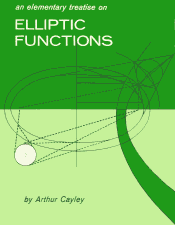|
home |
index |
units |
counting |
geometry |
algebra |
trigonometry |
calculus |
functions
analysis | sets & logic | number theory | recreational | misc | nomenclature & history | physics |
Final Answers
| |||||||||
Related topics on this website include:
- Surface of an ellipse.
- Volume of an ellipsoid.
- Ellipses and Hyperbolas.
- Hypergeometric functions.
- Arithmetic-geometric mean.
- Ellipse rolling on a sinewave.
- Gears syntrepent to an ellipse.
- Perimeter of an ellipse. Exact formulas and simple ones.
- Circumference of an ellipse: Unabridged discussion.
- Surface area of an ellipsoid of revolution (oblate or prolate).
- Elliptic arc: Length of the arc of an ellipse between two points.
- Volume & hyper-surface area of an hypersphere in any dimension.
|
||||||||||||||||||||||||||||||||||||||||||||||||||||||||||||||||||||||||||||||||||||||||||||||||||||||||||||||||||||||||||||||||||||||||||||||||||||||||||||||||||||||||||||||||||||||||||||||||||||||||||||||||||||||||||||||||||||||||||||||||||||||||||||||||||||||||
The next formula along the same road features a ratio of two cubic polynomials.
It's certainly not an easy-to-remember expression,
but it's much more accurate than any of the above for round ellipses,
as it boasts a relative error of about
Such formulas are probably best obtained using a device which is to analytic functions
what truncated continued fractions are to real numbers.
The above ratio is equal to the following expression,
truncated "at order m=6",
where the coefficients to use are:
Truncating at m=3 gives Hudson's formula,
while Jacobsen's formula corresponds to m=4.
Truncation at m=2 yields a
The proper sequence of coefficients [1, 4, -4, 4/3, -4, 12/11...]
is not too difficult to obtain:
Consider a function f(h) which is to be approximated in this way
[if we only want the above coefficients up to am,
we may replace an analytic function
In general, a relation of the type
In the above, an odd order of truncation (m) gives a rational approximation
where the degree of the numerator is one unit higher than the degree of the denominator.
If we apply the method to 1/f(h) instead
[and take the reciprocal of the result]
we obtain a numerator of lower degree than the denominator.
(At even orders of truncation, the results of the two approaches coincide.)
For this "reciprocal" approach, the sequence of coefficients is:
1,
Improving Ramanujan's second formula [over the entire range of h]. Like most historical approximations to the perimeter of an ellipse, the second formula of Ramanujan reaches its worst relative error for a degenerate ellipse: Its O(h5 ) relative error reaches a maximum of (7p/22-1) for a flat ellipse (h = 1).
Therefore,
the following formula is exact for a flat ellipse while retaining the same leading error
term for a roundish ellipse as Ramanujan's second formula,
provided f is
David W. Cantrell has proposed the O(h12 ) correction f = h6 , for a relative error never worse than ±15 ppm. This proposal was spurred by a more complex correction term presented to him by Edgar Erives. The exponent 6 is merely the integer closest to an optimal exponent which is only minutely better. On 2004-06-06, Ricardo Bartolomeu asked us to evaluate a [very messy] trigonometric approximation of the perimeter of an ellipse, which he had stumbled upon, with apparently good results. Miraculously, Bartolomeu's expression happens to be equivalent to a nice symmetric function of a and b: P » p (a-b) / arctg [ (a-b) / (a+b) ] = p (a+b) [ 1 + h/3 + O(h2 ) ] This simple formula is defined by continuity for a = b. It's exact for a circle and a flat ellipse and is about 5 times less accurate than the YNOT formula (both for low eccentricities and over the entire range, with a worst relative error exceeding 1.72 % for an ellipse of eccentricity near 0.983). This goes to show that even wild guesses can be fairly accurate if they turn out to be symmetrical. In 1932, E.H. Lockwood had proposed a similar approximation of the perimeter of an ellipse, which has a worst relative error of almost -0.9% (when e»0.9598). It's about four times less accurate than the YNOT formula for a round ellipse: P » (4b2/a) arctg (a/b) + (4a2/b) arctg (b/a) = p (a+b) [1 + (4-12/p)h + ...] Another attempt...On 2004-08-02, Ricardo Bartolomeu asked us again to evaluate yet another [slightly less messy] trigonometric approximation for the perimeter of an ellipse, which could be reduced to the following asymmetrical formula:
Again, this is defined by continuity for a = b (sin(x)/x tends to 1 as x tends to 0) and the formula is exact for a circle, a flat ellipse, or an ellipse of eccentricity: 0.88729428292031793745442629632208285906244622844440758655... Below that, the relative error is negative but never worse than -0.184 % (for eccentricities around 0.766764) above that, it's positive but never worse than +0.9822 % (almost reached for an ellipse of eccentricity around 0.991233). For the perimeter of an ellipse of low eccentricity e, the relative error is: -e4 (p2-6) / 384 + e6 (12-p2 ) / 768 + O(e8) That's more than 9.23 times worse than the commensurable YNOT formula... Evaluating the performance of yet another proposal... Although I no longer honor requests to evaluate the performance of new approximative formulas for the perimeter of an ellipse, the following formula submitted by Khaled Abed (on behalf of his father Hassan) deserves a second look, especially if we put it in parametric form (the nonparametric form originally proposed by Abed corresponds to k = 1/512 ).
P » p
(a+b)
(1 + h/4)(1/2 + k h4 ) (1 +h2/16)-¼
(1 - h/4)-½
In the main, the above square bracket differs from the correct Gauss-Kummer series by the following quantity, which is therefore the relative error for the perimeter of a roundish ellipse using Abed's formula (see above analysis). +h 4 / 16384 + O( h 5 ) = e16/230 [ 1 + 4e2 ] + O( e 20 ) For a roundish ellipse, this is commensurate with Hudson's formula (the relative error is 9 times smaller than with Hudson's formula and it's of opposite sign). What's interesting is that this nice performance about h = 0 does not depend on the value of k (which affects only the fifth order in h ). So, the parameter k can be adjusted to optimize whatever characteristic is deemed desirable outside the immediate neighborhood of zero... To make the formula exact for h = 1 (a flat degenerate ellipse) we'd put: 4 / p = (5/4)(1/2 + k) (17/16)-¼ (3/4)-½ That's k = (1/4) Log ( 2448 / 25p4 ) / Log ( 5/4 ) = 3.00077346... / 512 This value of k is the lowest which will make Abed's formula a lower bound to the perimeter of the ellipse and it will never exceed the true value by more than 213.86 ppm The worst case being reached when b/a is around cos(88.317°). For k = 3/512 the worst case is a relative error of +213.67 ppm (it is then equal to -0.337 ppm for a flat ellipse). The value k = 2.676464 / 512 optimizes the worst relative error over the whole range of aspect ratios, making it equal to ±141.333 ppm. The value k = 1/512 originally advocated by Abed, yields a relative error between +871.62 ppm and -1.02 ppm. On 2009-04-21, Shahram Zafary (from Semnan, Iran) posted a note introducing the following approximation for the circumference of an ellipse: P » 4 ( a + b ) (p/4) 4 ab / (a+b)2 With our usual notations, this is equivalent to a very simple expression:
In the main, for a roundish ellipse, this yields a negative relative error of - e4 ( 1 + e2 ) ( 1+ 4 Log p - 8 Log 2 ) / 64 + O(e8 ) That's about -0.00052722 e4 (roughly half the error of the YNOT formula).
Overall, the relative error is negative for low eccentricities,
reaches a minimum of David Rivera (of the Naval Undersea Warfare Center, RI) has contacted us to share this approximation, developed around 1997 for his antenna work:
This formula clearly gives the correct circumference for a circle (a = b) and a flat ellipse (b = 0). It is also exact for an ellipse of eccentricity e = 0.986118932960305275314772672749686388... For a rounder ellipse, Rivera's formula features a negative error which is never worse than -103.70 ppm (when e is around 0.9329538). For a flatter ellipse, the error is positive, but never worse than +103.73 ppm (for e around 0.99811). All told, the relative error of Rivera's 1997 formula is always better than 104 ppm and is thus almost as good as Cantrell's 2001 formula. (104 ppm vs. 83 ppm) The value p = 89/146 is an approximation for the value that minimizes the magnitude of the worst relative error(s) in a parametrized formula which, incidentally, could be rewritten as follows, for any value of p : P » p (a+b) [ 1 + (4/p-1) h - (p/4p) {1 - h - (1-h) 3/2 } ] For any p, that parametrized version is exact for a circle (h=0) or a flat ellipse (h=1). The optimal value of p for low eccentricities is 32-10p. David F. Rivera had submitted another approximation among errata to the 30th edition of the Standard Mathematical Tables and Formulas (CRC Press)... This formula is the only one of its kind given in the 31st edition. [ Thanks to David Cantrell for pointing this out. ] P » 2a [ 2 + (p - 2) (b/a) 1.456 ] This asymmetrical expression is exact for a circle or a flat ellipse. The relative error is also zero for an ellipse of eccentricity around 0.921271. Below that point, it's negative but never worse than -0.447 % (around 0.7129); above that point, it's positive but never worse than +0.439 % (around 0.9883). Cantrell considers approximations to the perimeter of the ellipse of the form: P » 4(a+b) - 2(4-p) ab / f This always gives an exact result for flat ellipses (b = 0). Furthermore, if f (a,b) = a when a = b, then it's also exact for circles... In his original 2001 proposal, Cantrell had used f = [ ½ (ap+bp) ] 1/p, the Hölder mean of the principal radii ( p = 33/40 yields an 85 ppm accuracy). Seeking better accuracy and computational simplicity, he now introduces a two-parameter expression for f (the more parameters to optimize, the better) which makes f equal to a when a = b, for any choice (within limits) of p and k :
For an ellipse of low eccentricity, this yields an optimal O(h3) error when:
Numerically, that's approximately k = 133 and p = 0.412. However, Cantrell's primary concern is to minimize the worst relative error. For this, he settles on k = 74 and uses an approximation of the corresponding optimal value of p (0.410117...) to claim an overall accuracy of 4.2 ppm. C.K. Lu rediscovers (2003) an expansion due to Euler (1773). In 1773, Leonhard Euler (1707-1783) gave an exact expansion for the perimeter of an ellipse which may be expressed as a power series of the quantity d defined below. By itself, the first term of this expansion gives Euler's crude approximation, which has been discussed above...
where d = [ (a2 - b2 ) / (a2 + b2 ) ] 2 = 4h / (1+h)2
The partial expansion up to d n yields a relative error of 1/16n+O(1/n2) for a flat ellipse (another approach is recommended in that case). Some of the above exact series may be expressed using Gauss's (1812) hypergeometric function F (also denoted 2F1 ).
|
|||||||||||||||||||||||||||||||||||||||||||||||||||||||||||||||||||||||||||||||||||||||||||||||||||||||||||||||||||||||||||||||||||||||||
 (Jaleigh. B. of Minonk, IL.
(Jaleigh. B. of Minonk, IL.

